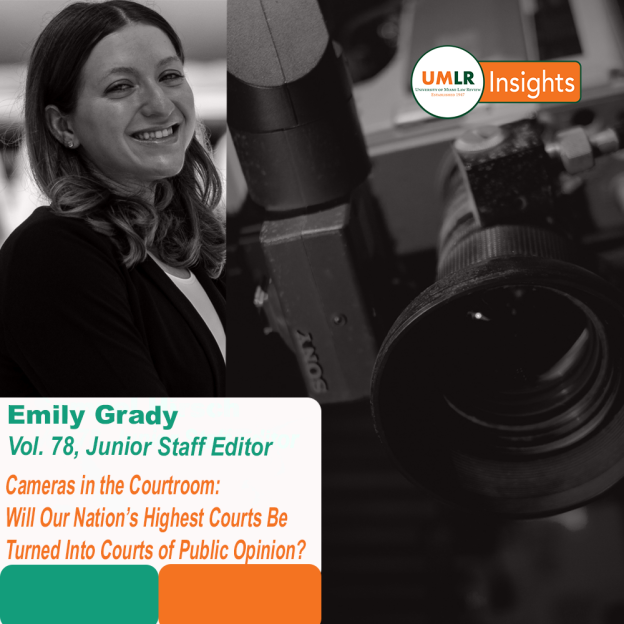EMILY GRADY—In March of this year, two bills were introduced in Congress to increase public access to both the federal courtrooms and the Supreme Court of the United States. The bill pushing for media coverage in the federal courtrooms gives the presiding judge the authority to permit a wide variety of media coverage including broadcasting, televising, electronic recording, and photographing. However, this discretion is limited by considerations of the due process rights of the defendant and the safety of the witnesses involved. Similarly, the bill related to the Supreme Court calls for an authorization of “television coverage of all open sessions of the Court,” unless a majority of the justices vote to bar the coverage because of the due process interests involved. As shown in the plain text of these bills, the competing interests at issue are public transparency and the defendant’s right to a fair trial.
These bills, although not the first of their kind, have once again reinvigorated the debate involving these interests. At the heart of this controversy lies a question about whether public transparency in the form of camera access in our nation’s highest courts is necessary or beneficial.
Some proponents of these bills feel that camera access would not impact a trial or the outcome at all and instead suggest that camera access would give people an “unbiased, unfiltered view of the justice system,” which would give Americans the level of transparency needed to accept the outcomes of cases. Supporters often point out that almost every state has allowed cameras into their courtrooms for many years without any of the procedural problems that the bills’ opponents fear. Moreover, some of the federal sessions are already open to the public but with limited in-person seating, so proponents of these bills suggest that allowing the camera into the courtroom would only bolster the access that is already allowed. Supporters also propose that camera access will keep the Supreme Court and federal courts accountable.
On the other hand, critics of the bill point out that “[a]ccountability doesn’t, in fact, translate to video recordings.” Critics state that realistically all the public needs in terms of transparency and accountability is the opinion itself because the opinion explains how the court reached their result. Moreover, critics have called attention to the fact that the courts are supposed to interpret the law irrespective of what the public thinks. In fact, some critics have suggested that unfettered camera access to the Supreme Court and other federal courtrooms would transform the courts into Congress. While Americans rightfully have the ability to participate in and view the business of Congress because congressmembers are directly elected by and accountable to their electorates, judges at the federal level are not popularly elected and are instead nominated by the President and confirmed by the Senate. Therefore, our Constitutional design insulates federal judges, including the justices on the Supreme Court, from public opinion.
A related concern is that allowing access to the Supreme Court and federal courts would dimmish the quality of the judicial proceedings because judges would likely censor themselves, lawyers would strive for memorable “sound bites,” and witnesses might change their behavior to play to the cameras. All of these seemingly small changes put together could have a serious effect on the jury’s ability to perform their essential functions of evaluating the evidence and thus lead to an unfair trial for the defendant.
A handful of trials have become media frenzies in the past, like O.J. Simpson’s case, which became a media sensation due to the live broadcasting of the trial over several cable networks. Now, however, we are in a completely different world because advances in technology have created new levels of accessibility. And streaming services have already begun to capitalize on the public interest in high-profile trials, such as Alex Murdaugh’s and Johnny Depp/Amber Heard’s. In the latter case, which was a state trial that allowed camera access to the courtroom, the Netflix short series featured not only portions of the live court proceedings, but also other individual’s livestreamed reactions and comments to each step of the trial. Because of the camera access to the courtroom and new technology that made the trial extremely accessible to the public, some speculate that despite the court’s best effort to seclude the jurors from the media attention the case was receiving, the jurors quite possibly were tainted by the public opinions that were circulating at the time. This seems to give some merit to the view that camera access will affect the outcome of trials.
Regardless of the strength of the arguments advanced on either side of these bills or whether these bills will become laws, the competing interests raised in this ongoing debate seem particularly relevant in an age where streaming is at an all-time high and high-profile cases, like Trump’s, loom on the horizon. At this point in time, the bills are still pending before Congress, and it is yet to be seen whether our courtrooms will be transformed into courts of public opinion.






